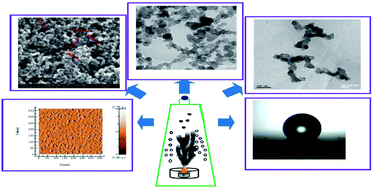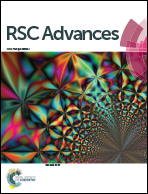Photoluminescent carbon soot particles derived from controlled combustion of camphor for superhydrophobic applications
Abstract
The present perspective presents a novel platform for the synthesis of catalyst free photoluminescent carbon nanoparticles derived from the combustion of camphor in a single step flame process. The soot particles were investigated using Fourier transformation infrared spectroscopy, thermogravimetry, Raman, transmission emission microscopy, X-ray diffraction, UV and photoluminescent spectroscopy. The soot particles exhibited a diamond-like carbon nanostructure, with the presence of hydrophobic functional groups imparting superhydrophobic characteristics. The camphor soot particles revealed the presence of highly graphitized amorphous carbon, which was confirmed by the appearance of G, D1 D2, D3 and D4 bands in the Raman spectra. Photoluminescence of the soot particles was observed when soot particles were excited at λmax. A red shift was clearly noted in the UV spectrum of the soot in different solvents. The agglomeration of camphor soot particles was discussed by measuring the fractal dimensions (Df) of the particles. Combustion of soot particles occurs at 450 °C, approx. 100 °C lower than that of graphene. In-depth investigations suggest the use of these photoluminescent camphor soot particles for superhydrophobic coating applications.


 Please wait while we load your content...
Please wait while we load your content...